
Tips & Advice for Car, SUV & Van tires
The tire sidewall is the vertical area of the tire between the tread and the bead (the part that sits on the wheel rim). It forms the outer walls on both sides of the tire. Its main function is to maintain the tire’s shape under load, providing lateral stability to the tire, and helping absorb some impact from road shocks.
A tire’s sidewall also displays important tire information such as tire size, speed rating, manufacturer details, manufacturing date, maximum inflation pressure, and more important information.
Under certain conditions, the tire sidewall can be damaged to some extent. Tire damage on the sidewall can cause sudden tire failure or unpredictable handling, leading to accidents. What types of damage can occur? When does it happen? What actions should be taken? How can you prevent tire damage? Find out in this article.
What types of tire damage can occur on the sidewall?
Understanding the different types of tire damage is crucial for maintaining your vehicle's safety. Sidewall damage ranges from minor issues to severe structural problems in 6 main categories as follows:
1 - Tire sidewall scratches and nicks
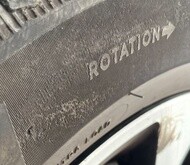
Scratches may appear on the sidewall of your tires. Minor scratches that don't penetrate the rubber are usually cosmetic. However, they may allow moisture and debris to enter, causing further damage. Monitor these scratched areas for any changes. If they are numerous and/or pronounced, you should have your tires examined by a professional.
2 - Tire sidewall cuts
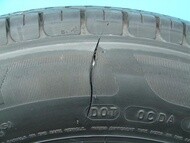
A cut in the tire sidewall can be more or less deep. The severity of the cut will depend on this. However, it is difficult for a non-expert to assess its depth.
- If the cut is not deep, it may not be an immediate danger, but it could escalate and compromise your safety.
- If the cut is deep, it may have damaged the carcass ply that lies under the rubber and helps contain the pressure. If the carcass ply is damaged, there is a risk of sudden pressure loss. In this case, the tire is not repairable and needs to be replaced.
It's important to note that tire damage can occur on the inner sidewall, which isn't visible during a regular vehicle inspection, as well as on the outer sidewall. Therefore, if you drive over sharp objects like sharp stones, it's advisable to have your tires checked to ensure they are free from cuts, particularly on the inner sidewall.
3 - Tire sidewall bulges and bubbles
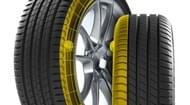
When your vehicle drives onto a kerb, either from the front or at an angle, it can cause a bulge on the sidewall of a tire. Manufacturing defects can also cause this. It looks like a bubble forming on the tire sidewall. It is probably one of the most alarming signals as it constitutes a real danger.

Pothole tire damage
Driving into a pothole can also cause a bulge on your tire sidewall. Try to avoid them when you see them on the road!
If you do hit a kerb or a pothole, you should have your tires checked to see if they have been damaged or not.
Why is a tire bulge dangerous?
If you notice a bubble on the sidewall of your tire, it means that the inner part of the tire has been punctured. This puts you at risk of sudden air loss if the bubble bursts. If this happens while driving at high speeds, such as on a highway, it could cause you to lose control of your vehicle and result in an accident.
A tire can bulge on the inner or outer sides, which may not be visible when you check your vehicle. But if there is a bulge, you may feel abnormal vibrations. This is a sign that should not be taken lightly and that your tires should be checked urgently by a professional.
Can speed bumps damage tires and cause a bulge?
No. As they are designed with a slope to go up and down, they may damage the suspensions, but not the tire.
4 - Tire sidewall cracks

Sidewall cracks are a sign of tire aging and exposure to sun and ozone.
Another cause may be the cleaning of the sidewall of the tires. If you use chemicals to shine your tires, they may remove the protective agents and therefore expose your tires to cracking more quickly.
The appearance of cracks in the tire sidewall is a warning sign that the tire is nearing the end of its life and that you should prepare to change it. You can consult a professional for advice.
The appearance of cracks in the tire sidewall is a warning sign that the tire is nearing the end of its life and that you should prepare to change it. You can consult a professional for advice.
5 - Tire sidewall slight deformation
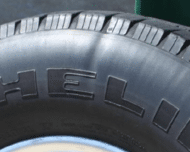
It's normal for radial tires to have slight deformations, which don't affect their performance. The sidewall of the tires is made up of different components, including plies (textile or metal). You might notice a slight deformation where the plies overlap.
You will often notice a slight deformation where the plies overlap.
6 - Tire sidewall puncture
The part of the tire that makes contact with the ground surface, known as the tire tread, can be repaired if it gets punctured by a nail.
The hole is filled in and once the tire is reassembled, it can be driven again with the same performance.
However, if the tire sidewall is punctured, it cannot be repaired to regain its original performance. In this case, the tire must be replaced as soon as possible for your safety.
The good news is if your car is equipped with runflat tires, you might be able to drive to the nearest garage safely even after sudden pressure loss.
Each of these damage types presents unique risks and requires different approaches for treatment. By learning these various forms of sidewall damage, you'll be better equipped to identify potential issues early and take appropriate action to ensure your tires remain in optimal condition.
How to prevent tire sidewall damage
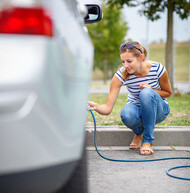
Even if you don’t see any damage to the tire's sidewall, it’s best to follow these guidelines to lower the risk of potential issues:
- Make sure your tires are inflated to the recommended pressure. You can usually find this information in your vehicle manual or a sticker on the driver's door.
- Avoid bumping into kerbs
- Avoid driving into road debris or potholes.
- Inspect your tires regularly for cracks, cuts, tears or bulges
- Avoid cleaning the sidewall of your tires with cleaning products, especially those containing silicone.
When it comes to tire damage, you should always be careful and take action early. If you are unsure, consult a tire specialist near you to ensure your safety.
Find the right tyre
Enter your vehicle or tyre size
We're searching for your tyre...
Wait few seconds we're processing your photo



